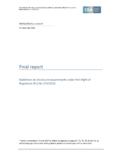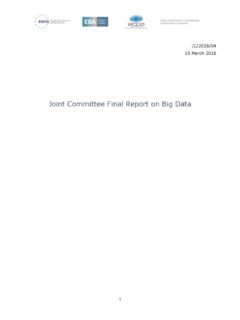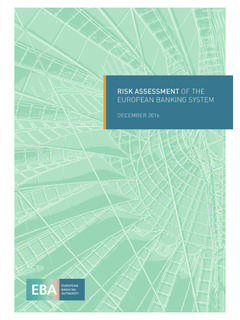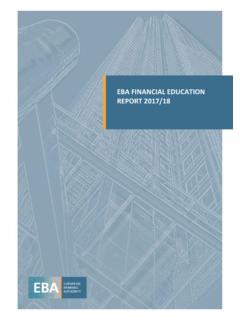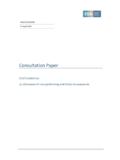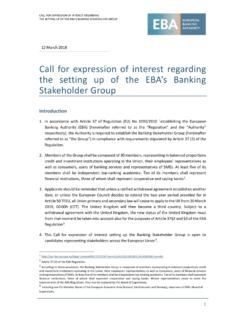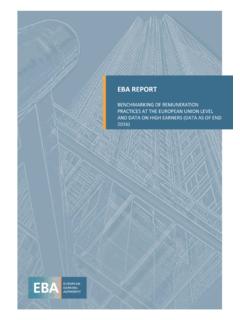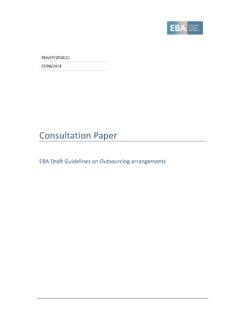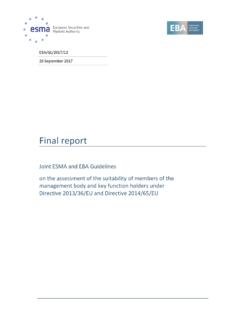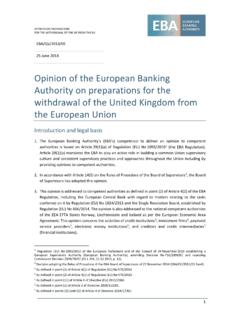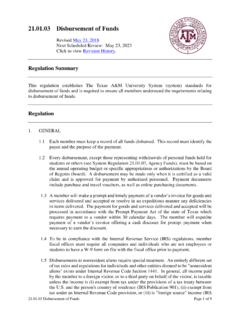Transcription of EBA BS 2017 XX (Final Guidelines on Accounting for ECL)
1 EBA/GL/2017/06. 12 May 2017. final Report Guidelines on credit institutions' credit risk management practices and Accounting for expected credit losses final REPORT ON Guidelines ON. CREDIT INSTITUTIONS' CREDIT RISK MANAGEMENT PRACTICES AND. Accounting FOR EXPECTED CREDIT LOSSES. Contents 1. Executive Summary 4. 2. Background and rationale 7. Guidelines 11. on credit institutions' credit risk management practices and Accounting for expected credit losses 11. 1. Compliance and reporting obligations 12. 2. Subject matter, scope, addressees and definitions 13.
2 3. Implementation 16. 4. Guidelines on credit risk management practices and Accounting for expected credit losses 17. General provisions 17. Principles on credit risk management practices and Accounting for expected credit losses 18. Guidelines specific to credit institutions applying IFRS 9 36. Supervisory evaluation of credit risk practices, Accounting for expected credit losses and capital adequacy 49. 5. Accompanying documents 53. Cost-benefit analysis/impact assessment 53. Feedback on the public consultation 65. 2. final REPORT ON Guidelines ON.
3 CREDIT INSTITUTIONS' CREDIT RISK MANAGEMENT PRACTICES AND. Accounting FOR EXPECTED CREDIT LOSSES. 3. final REPORT ON Guidelines ON. CREDIT INSTITUTIONS' CREDIT RISK MANAGEMENT PRACTICES AND. Accounting FOR EXPECTED CREDIT LOSSES. 1. Executive Summary These Guidelines are issued pursuant to Article 16(1) of Regulation (EU) No 1093/2010 on the EBA's own initiative in order to ensure common, uniform and consistent application of Union law and to establish consistent, efficient and effective supervisory practices within the European System of Financial Supervision ( ESFS').
4 A significant number of credit institutions apply the International Financial Reporting Standards . ( IFRS Standards') as these are incorporated into the EU legal framework through EU regulations , in accordance with the procedures set out in Regulation (EC) No 1606/2002 1. IFRS 9 Financial Instruments ( IFRS 9'), which will replace IAS 39 Financial Instruments: Recognition and Measurement ( IAS 39'), for the Accounting periods beginning on or after 1 January 2018 2 , requires the measurement of impairment loss allowances to be based on an expected credit loss ( ECL') Accounting model rather than on an incurred loss Accounting model.
5 The EBA welcomes the move from an incurred loss model to an ECL model under IFRS 9 3. IFRS 9 is, overall, an improvement compared with IAS 39 in the Accounting for financial instruments, and the changes to credit loss provisioning should contribute to addressing the G20's concerns about the issue of too little, too late' recognition of credit losses, and improve the Accounting recognition of loan loss provisions by incorporating a broader range of credit information. IFRS 9. is therefore expected to address some prudential concerns and contribute to financial stability.
6 However, the application of IFRS 9 also requires the use of judgement in the ECL assessment and measurement process, which could potentially affect the consistent application of IFRS 9 across credit institutions and the comparability of credit institutions' financial statements. In December 2015, the Basel Committee on Banking Supervision ( BCBS') issued supervisory guidance on credit risk and Accounting for expected credit losses 4 (the BCBS guidance'), which sets out supervisory expectations for credit institutions related to sound credit risk practices associated with implementing and applying an ECL Accounting model.
7 In addition, it contains an Annex specific to jurisdictions applying IFRS. Building on the BCBS guidance, these Guidelines aim at ensuring sound credit risk management practices for credit institutions, associated with the implementation and ongoing application of ECL Accounting models. The existence of supervisory guidance emphasises the importance of 1. Regulation (EC) No 1606/2002 of the European Parliament and of the Council of 19 July 2002 on the application of international Accounting standards (OJ L 243, , p. 1). 2. Commission Regulation (EU) No 2016/2067 of 22 November 2016 amending Regulation (EC) No 1126/2008 adopting certain international Accounting standards in accordance with Regulation (EC) No 1606/2002 of the European Parliament and of the Council as regards International Financial Reporting Standards 9.
8 3. Letter to the European Financial Reporting Advisory Group ( EFRAG') of 26 June 2015 with EBA's views on the adoption of IFRS 9 Financial Instruments ( +to+EFRAG+Board+on+IFRS+9+ ). 4. Guidance on Accounting for expected credit losses ( ). 4. final REPORT ON Guidelines ON. CREDIT INSTITUTIONS' CREDIT RISK MANAGEMENT PRACTICES AND. Accounting FOR EXPECTED CREDIT LOSSES. high-quality and consistent application of IFRS 9 and could help to promote consistent interpretations and practices. The objective of the EBA Guidelines is to be in line with the BCBS.
9 Guidance. The EBA Guidelines would not prevent credit institutions from meeting the impairment requirements in IFRS 9. These Guidelines should be read in conjunction with the provisions of Regulation (EU) 575/2013. and Directive 2013/36/EU regarding internal governance, credit risk, disclosures, supervisory review and evaluation process and requirements, and supervisory measures and powers, as supplemented by the relevant technical standards adopted by the Commission and as further developed by the technical standards and Guidelines issued by the EBA.
10 The Guidelines include four main sections as follows: Section includes some general considerations on the application of the principles of proportionality and materiality, and the use of information by credit institutions. Section includes eight principles, also addressed to credit institutions, which relate to the provisions for the main elements of credit risk management and Accounting for ECL, and provide detailed guidance for the application of each principle. Section includes guidance specific to credit institutions reporting under IFRS and is limited to providing guidance on certain aspects of the ECL requirements in the impairment section of IFRS 9 that may not be common to other ECL Accounting frameworks.
